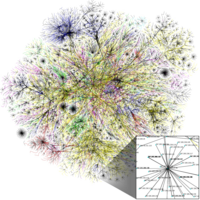
Photo from wikipedia
Children’s peer social worlds as part of language and literacy learning are often “hidden” from researchers and teachers alike. This article reports on collaborative research between a researcher and veteran… Click to show full abstract
Children’s peer social worlds as part of language and literacy learning are often “hidden” from researchers and teachers alike. This article reports on collaborative research between a researcher and veteran kindergarten teacher into these hidden worlds. We draw upon ethnographic documentation (videos, interviews, field notes) and video microanalysis with two aims for our inquiry. For one, we are interested in the teacher’s perspective on children’s peer reading behaviors and what children are learning as part of these practices. Secondly, we reflect on how using video to look closely into hidden classroom life contributes to teacher learning. The result is a detailed analysis from the teacher’s perspective of how children acquire both the character and skills for learning to read when reading with a peer. Findings contribute to literatures on the sociolinguistic features of children’s peer reading and teacher development in literacy education.
Journal Title: Journal of Early Childhood Research
Year Published: 2021
Link to full text (if available)
Share on Social Media: Sign Up to like & get
recommendations!